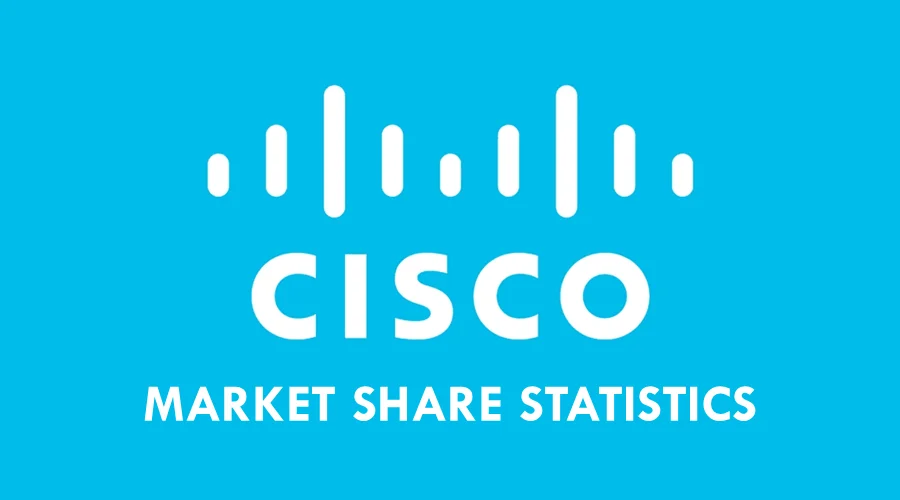15+ Cisco Market Share Statistics That Show How Big It Is in 2025
7 min. read
Updated on
Read our disclosure page to find out how can you help VPNCentral sustain the editorial team Read more

Cisco provides almost half of the world’s internet networking equipment. And chances are your connection passed through its hardware to get here.
Surprised? Don’t be!
This vendor is always at the forefront of innovating web-accelerating technologies. Be it routers, network switches, firewalls, or VPNs – its presence is virtually everywhere.
But how does it stack up against the competition? Discover for yourself in the Cisco market share analysis below.
Fascinating Cisco market share statistics
Check out some quick facts about Cisco here:
- Cisco controls 46% of the Ethernet switch industry.
- 37.9% of enterprise routers worldwide come from Cisco.
- The company is the world’s third-largest supplier of enterprise-grade firewall hardware.
- 98% of Fortune 500 companies use solutions developed by Cisco.
- 25% of Cisco’s customers are in the telecoms industry.
- The United States is Cisco’s biggest market by 43.09%.
- Cisco’s revenues stood at $51.6 billion in 2022.
Now, let’s dive deeper into these numbers.
General Cisco market share statistics
As you’ll see below, Cisco is consistently outperforming its competitors on nearly every metric. And while rivalry still exists, big challenges are few and far between.
1. Cisco supplies almost half of Ethernet switches globally.
(Source: IDC)
Cisco single-handedly supplies about 46% of Ethernet switches on the global market. They’re critical components that allow the devices in cable networks to communicate.
The competition lags far behind with the following distribution:
- Arista Networks – 11.4%
- Huawei – 6%
- Hewlett Packard Enterprise (HPE) – 7%
- H3C Technologies – 3.6%
As you can see, even combined, Cisco’s closest rivals can’t match its reach in the field.
2. About 40% of enterprise routers come from Cisco.
(Source: IDC)
Ethernet switches aren’t the only sector where Cisco dominates. It also enjoys 37.9% of the enterprise routers market worldwide.
The figure comprises an 18.2% growth realized at the beginning of 2023. A strong 13.1% year-over-year (YoY) increase in demand fueled this growth.
But fierce rivalry still exists.
3. Cisco was the world’s third-largest supplier of enterprise-grade firewalls in 2023.
(Source: IDC)
Cisco provides about 15.8% of firewall hardware, waging the war against cyber attacks. That’s a tie with second-placed Fortinet, which also has a share of 15.8%.
Palo Alto Networks leads the pack with 15.9%. Check Point and SonicWALL have 7.7% and 3.2%, respectively.
The remaining vendors share 42.3% of the market.
4. 98% of Fortune 500 companies use Cisco.
(Source: Cisco)
About 98% of Fortune 500 companies trust Cisco’s networking technologies solutions. The company attributes this to having quality products backed by excellent customer support.
5. A quarter of Cisco’s customers belong to the telecoms industry.
(Source: 6sense)
Industry figures show Cisco’s biggest customers are in the telecommunications industry. The rest follow suit with notable figures.
Here’s how the top seven compare:
- Telecommunications – 25%
- Managed services – 17%
- Internet – 14%
- Cloud – 13%
- Computing – 12%
- Datacenter – 11%
- Cyber security – 10%
6. As of 2022, Cisco’s brand value earned it the second spot internationally.
(Source: Statista)
Cisco has a brand value of $26.6 billion. This earns it a second spot amongst global telecoms infrastructure vendors.
While that’s tremendous, it’s far off Huawei’s $71.2 billion commanding lead. Still, it’s way ahead of Nokia, Qualcomm, ZTE, Juniper, etc.
Curious to know the figures?
- Huawei – $71.2 billion
- Cisco – $26.6 billion
- Nokia – $9 billion
- Qualcomm – $7.8 billion
- ZTE – $3.7 billion
- Ericsson – $3 billion
- Corning – $2.2 billion
- Juniper – $1.1 billion
- Hengtong – $900 million
- ZTT – $700 million
7. Cisco is the global leader in the commercial VPN industry.
(Source: Statista)
With a market share of 28.6% in 2022, Cisco AnyConnect leads the global commercial VPN software industry. Its biggest competitor is Juniper VPN with a 10.62% share.
8. Cisco accounts for over 60% of Cloud UC platforms.
(Source: Cisco)
Almost two-thirds of cloud calling platforms use systems from Cisco.
Its solutions are popular due to easy installation and integration into the cloud. Moreover, the vendor has over 450 global partners, recommending its services to clients.
Cisco vs Juniper market share stats
Juniper may not be a big name like Cisco. But it’s a popular choice for consumers looking for affordable options.
9. Cisco is over sixteen times larger than Juniper.
(Source: Trefis)
Cisco’s market capitalization of $214 billion is over sixteen times larger than Juniper’s $9.1 billion. However, Cisco recorded a 4% lower revenue growth than its rival.
This shows Juniper is slowly gaining popularity on the market.
10. Cisco and Juniper go head-to-head in network administration and management solutions.
(Source: 6sense)
Cisco commands 20.51% of the network administration and management market. Juniper edges closer with a 15.64% share.
11. Cisco is the preferred choice over Juniper in cloud networking.
(Source: 6sense)
Cisco’s narrow 54% lead over Juniper’s 46% is evident in cloud networking solutions.
The difference reflects in cloud computing, where the former has 53.05% over its rival’s 46.95%. But Cisco widens the gap in cloud services with 63.91% against Juniper’s 36.09%.
12. Cisco has a wider reach than Juniper globally.
(Source: 6sense)
Cisco is popular across North America, Russia, Australia, and Africa. But Juniper narrows the gap in regions like South America, Africa, and Europe.
Here are the approximates relative to their market share:
| Region | Cisco | Juniper |
| North America | 61.8% | 24.7% |
| South America | 30% | 18% |
| Europe | 34.1% | 17.3% |
| Africa | 29.4% | 14.4% |
| Australia | 38.8% | 17.4% |
| South East Asia | 31% | 7% |
| Russia | 29.2% | 17% |
Cisco revenue statistics
Cisco’s router and Ethernet switch market share dominance contributes enormously to its revenues. Let’s break them down next:
13. Cisco generated revenue of $51.6 billion in 2022.
(Source: Statista)
Cisco saw revenues reach $51.6 billion in 2022, which represents a 3.6% growth from the previous year.
This shows the company is on its way to exceed the highs of $51.9 billion recorded in 2019. That’s because businesses are spending more, rebounding from the COVID-19 slowdown.
14. Cisco takes the lion’s share of networking equipment revenues.
(Source: IDC)
Cisco scoops a vast chunk of the networking equipment global revenues.
Data from Q1 of 2023 shows it took home around $4.6 billion from the market. The figure is almost half what the industry generated during the same time.
15. In Q4 of 2022, Cisco made revenues of $921.08 million from security appliance sales.
(Source: IDC)
Cisco made almost a billion dollars in Q4 of 2022 from selling security appliances (firewalls). This represented a 4% growth compared to 2021’s $885.79 million fourth-quarter sales.
However, it trailed behind Fortinet and Palo Alto Networks, which recorded impressive performance. The duo raked in $966.61 million and $973.75 million over the same period, respectively.
Cisco geographical stats
Cisco draws customers from every corner of the planet. Despite that, enormous support comes from its home turf, the United States.
16. Almost 45% of Cisco’s router customers are in the US.
(Source: 6sense)
43.09% of Cisco’s customers are in the United States. The country is followed by India and the United Kingdom with 8.53% and 6.22%, respectively.
Surprisingly, Pakistan ranks fourth with 5.71%. It’s ahead of Canada’s 4.21%, Australia’s 3.48%, and Brazil’s 2.75%.
17. About 75% of Cisco’s firewall users are in the United States.
(Source: 6sense)
72.5% of Cisco’s security appliance customers are in the United States. Germany, India, and the UK tie for second place with 3.66% each.
The rest of the regions are as follows:
- Netherlands – 2.67%
- Spain – 2.67%
- Brazil – 1.33%
Related Articles:
- VPN Connection Failed Due to Unsuccessful Domain Name Resolution
Fix this common VPN error by troubleshooting DNS settings and connection issues. - Cisco VPN Not Working on Windows 10
A practical guide to solving connectivity problems with Cisco VPN on Windows 10. - Hackers Are Actively Targeting Cisco VPNs
Learn how threat actors exploit vulnerabilities in Cisco VPN setups and how to protect yourself. - Cisco Warns of Brute-Force Attacks Targeting VPNs
Stay informed about ongoing brute-force attacks and Cisco’s recommendations to enhance VPN security.
Wrap up
This tech titan is like no other, judging by the Cisco market share stats above. It derives success from constant innovation and placing customer needs first.
Product diversification also enables the company to compete aggressively across different markets. Furthermore, it relies on strong regional partnerships to reach customers worldwide.
Even so, the competition is steadily catching up. It’ll be interesting to see how Cisco counters rivalry in the future.









User forum
0 messages